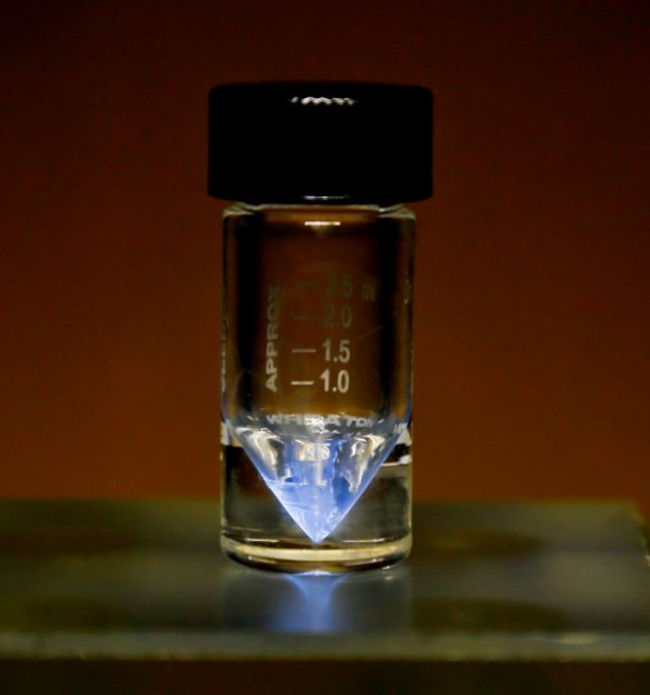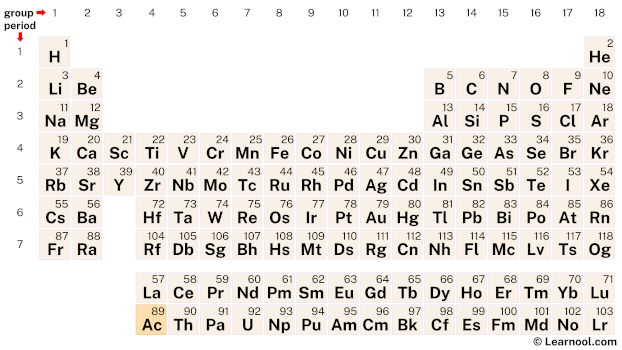
Actinium (Ac) is a chemical element of the periodic table, located in the period 7, and has the atomic number 89. It is the first element in the actinide series. It is a soft, silvery-white metal that glows in the dark with a blue light. Its name comes from the Greek word “aktis” or “aktinos”, which means beam or ray. It is counted as one of the radioactive elements.
On periodic table
| group | ⇨ | 1 | 2 | 3 | 4 | 5 | 6 | 7 | 8 | 9 | 10 | 11 | 12 | 13 | 14 | 15 | 16 | 17 | 18 |
| period | ⇩ | ||||||||||||||||||
| 1 | 1 H  Hydrogen |
2 He  Helium |
|||||||||||||||||
| 2 | 3 Li  Lithium |
4 Be  Beryllium |
5 B  Boron |
6 C  Carbon |
7 N  Nitrogen |
8 O  Oxygen |
9 F  Fluorine |
10 Ne  Neon |
|||||||||||
| 3 | 11 Na  Sodium |
12 Mg  Magnesium |
13 Al  Aluminium |
14 Si Silicon |
15 P  Phosphorus |
16 S  Sulfur |
17 Cl  Chlorine |
18 Ar  Argon |
|||||||||||
| 4 | 19 K  Potassium |
20 Ca  Calcium |
21 Sc  Scandium |
22 Ti  Titanium |
23 V  Vanadium |
24 Cr  Chromium |
25 Mn  Manganese |
26 Fe  Iron |
27 Co  Cobalt |
28 Ni  Nickel |
29 Cu  Copper |
30 Zn  Zinc |
31 Ga  Gallium |
32 Ge  Germanium |
33 As  Arsenic |
34 Se  Selenium |
35 Br  Bromine |
36 Kr  Krypton |
|
| 5 | 37 Rb  Rubidium |
38 Sr  Strontium |
39 Y  Yttrium |
40 Zr  Zirconium |
41 Nb  Niobium |
42 Mo  Molybdenum |
43 Tc  Technetium |
44 Ru  Ruthenium |
45 Rh  Rhodium |
46 Pd  Palladium |
47 Ag  Silver |
48 Cd  Cadmium |
49 In  Indium |
50 Sn  Tin |
51 Sb  Antimony |
52 Te  Tellurium |
53 I  Iodine |
54 Xe  Xenon |
|
| 6 | 55 Cs  Caesium |
56 Ba  Barium |
72 Hf  Hafnium |
73 Ta  Tantalum |
74 W  Tungsten |
75 Re  Rhenium |
76 Os  Osmium |
77 Ir  Iridium |
78 Pt  Platinum |
79 Au  Gold |
80 Hg  Mercury |
81 Tl  Thallium |
82 Pb  Lead |
83 Bi  Bismuth |
84 Po  Polonium |
85 At  Astatine |
86 Rn  Radon |
||
| 7 | 87 Fr  Francium |
88 Ra  Radium |
104 Rf  Rutherfordium |
105 Db  Dubnium |
106 Sg  Seaborgium |
107 Bh  Bohrium |
108 Hs  Hassium |
109 Mt  Meitnerium |
110 Ds  Darmstadtium |
111 Rg  Roentgenium |
112 Cn  Copernicium |
113 Nh  Nihonium |
114 Fl  Flerovium |
115 Mc  Moscovium |
116 Lv  Livermorium |
117 Ts  Tennessine |
118 Og  Oganesson |
||
| 57 La  Lanthanum |
58 Ce  Cerium |
59 Pr  Praseodymium |
60 Nd  Neodymium |
61 Pm  Promethium |
62 Sm  Samarium |
63 Eu  Europium |
64 Gd  Gadolinium |
65 Tb  Terbium |
66 Dy  Dysprosium |
67 Ho  Holmium |
68 Er  Erbium |
69 Tm  Thulium |
70 Yb  Ytterbium |
71 Lu  Lutetium |
|||||
| 89 Ac Actinium |
90 Th  Thorium |
91 Pa  Protactinium |
92 U  Uranium |
93 Np  Neptunium |
94 Pu  Plutonium |
95 Am  Americium |
96 Cm  Curium |
97 Bk  Berkelium |
98 Cf  Californium |
99 Es  Einsteinium |
100 Fm  Fermium |
101 Md  Mendelevium |
102 No  Nobelium |
103 Lr  Lawrencium |
|||||
| – f block |
Actinium (Ac) is located on the periodic table in the actinide series, which is a group of elements located at the bottom of the table. Specifically, in period 7, next to radium (Ra).
Element information
 |
|
 |
|
| Origin of name | Greek word “aktis” or “aktinos” (which means beam or ray) |
| Symbol | Ac |
| Atomic number (Z) | 89 |
| Atomic mass | (227) |
| Block | f-block |
| Period | 7 |
| Classification | Actinide |
| Covalent radius | 215 pm |
| Melting point | 1050 ℃, 1922 ℉, 1323 K |
| Boiling point | 3200 ℃, 5792 ℉, 3473 K |
| Electron configuration | [Rn] 6d1 7s2 |
| Electrons per shell | 2, 8, 18, 32, 18, 9, 2 |
| Crystal structure | Face-centered cubic (fcc) |
| Phase at r.t | Solid |
| Density near r.t | 10 g/cm3 |
| Natural occurrence | From decay |
| Oxidation state | +3 |
| Electronegativity (Pauling scale) | 1.1 |
| Protons Neutrons Electrons |
89 138 89 |
| CAS number | 7440-34-8 |
| Discovered by | André-Louis Debierne in 1899 |
History

Actinium was first discovered in 1899 by French chemist André-Louis Debierne. He separated a new radioactive element from uranium ore called pitchblende, which he named actinium. However, the discovery was later disputed as the sample he used was found to be contaminated with another element, thorium. It was only in 1902 that actinium was rediscovered by German chemist Friedrich Otto Giesel, who independently isolated the element from pitchblende. This time, the discovery was confirmed and recognized by the scientific community. In 1913, actinium was used for the first time in medical applications, when it was used to treat cancer. It was the first radioactive element to be used for cancer treatment. Today, actinium is still used in medical research and treatment, as well as in nuclear reactors for neutron production.
Occurrence and production
Actinium is one of the rarest and most expensive naturally occurring elements on Earth. Actinium is found in very small amounts in uranium and thorium ores, but it is not commercially extracted from them. The primary source of actinium is the decay of uranium and thorium, which are abundant in the Earth’s crust. Actinium is a product of the radioactive decay chain of uranium-235 and thorium-232. Uranium-235 decays into actinium-231, which in turn decays into protactinium-231 and finally into uranium-235. Similarly, thorium-232 decays into actinium-228, which decays into thorium-228 and eventually into lead-208.
Actinium is produced by bombarding a radium-226 target with neutrons in a nuclear reactor. The radium-226 captures a neutron and undergoes beta decay to form radium-227, which then decays into actinium-227. This process is known as neutron capture. Actinium can also be produced through the neutron irradiation of natural thorium or depleted uranium targets in a nuclear reactor. The irradiated target is dissolved in acid, and the actinium is separated from other elements using a series of chemical separation techniques, such as ion exchange and solvent extraction.
Properties
Actinium is a silvery-white radioactive metal that has a melting point of 1050 ℃ and a boiling point of 3200 ℃. It is highly reactive and can ignite spontaneously in air.
Actinium is a member of the actinide series, which includes elements with atomic numbers 89 to 103. It is the first element in this series, and its properties are similar to those of other actinides.
Actinium has three naturally occurring isotopes, with atomic weights of 225, 226, and 227. The most stable isotope is actinium-227, which has a half-life of 21.77 years.
Actinium is highly radioactive, and its decay releases alpha, beta, and gamma rays. It emits more alpha particles than any other element, making it a useful source of alpha particles for scientific research.
Actinium is highly toxic, and its radioactivity makes it a serious health hazard. Inhalation, ingestion, or skin contact with actinium can cause radiation poisoning, which can lead to cancer, organ damage, and death.
Applications
Actinium-225 is used in targeted alpha therapy (TAT) to treat cancer. Actinium-225 emits alpha particles that can kill cancer cells while minimizing damage to healthy cells.
Actinium-227 has a long half-life and can be used as a power source in nuclear batteries for space probes and remote devices.
Actinium-228 is used in radiation detectors for environmental monitoring and nuclear safety.
Actinium-227 is used as a tracer in medical research to study the uptake and distribution of drugs in the body. Actinium-228 is also used in scientific research to study nuclear physics and chemistry.
Actinium-227 and actinium-228 can be used as neutron sources in nuclear reactors for scientific research and industrial applications.
Actinium can be used to create luminescent materials, such as phosphors, for use in lighting and displays.
Interesting facts
Actinium is the first discovered and named element in the group of actinides.
It is a highly radioactive element and glows blue in the dark due to its intense radioactivity.
Actinium-225 is used in targeted alpha therapy for cancer treatment.
Actinium has a very high rate of neutron capture, making it useful in neutron radiography and in neutron activation analysis to detect trace elements in materials.
Actinium-227 is used as a neutron source in oil well logging, a technique used to measure the porosity and permeability of rock formations in oil wells.
Actinium has been used in the past as a component of portable X-ray machines.
Actinium is named after the Greek word “aktis”, which means beam or ray, due to its intense radioactivity.
Related
More elements
External links
- https://www.rsc.org/periodic-table/element/89/actinium
- https://en.wikipedia.org/wiki/Actinium
- https://www.britannica.com/science/actinium
- https://pubchem.ncbi.nlm.nih.gov/element/Actinium
- https://www.chemicool.com/elements/actinium.html
- https://www.americanelements.com/actinium.html
Deep
Learnool.com was founded by Deep Rana, who is a mechanical engineer by profession and a blogger by passion. He has a good conceptual knowledge on different educational topics and he provides the same on this website. He loves to learn something new everyday and believes that the best utilization of free time is developing a new skill.
